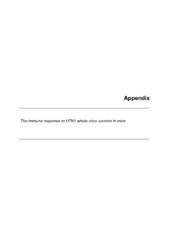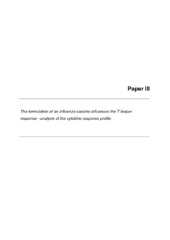| dc.contributor.author | Hovden, Arnt-Ove | en_US |
| dc.date.accessioned | 2006-01-06T13:46:10Z | |
| dc.date.available | 2006-01-06T13:46:10Z | |
| dc.date.issued | 2005-12-16 | eng |
| dc.identifier.isbn | 82-308-0075-8 | en_US |
| dc.identifier.uri | https://hdl.handle.net/1956/862 | |
| dc.description | The thesis is based on the following papers, which are referred to in the text by Roman numerals: Paper I: Hovden, A.-O., Cox, R. J., Haaheim, L. R. (2005) Whole influenza virus vaccine is more immunogenic than split influenza virus vaccine and induces primarily an IgG2a response in BALB/c mice. Scand J Immunol 62:36-43 - Paper II: Hovden, A.-O., Cox, R. J., Madhun, A., Haaheim, L. R. (2005) Two doses of parenterally administered split influenza virus vaccine elicited high serum IgG concentrations which effectively limited viral shedding upon challenge in mice. Scand J Immunol 62:342-352 - Paper III: Hovden, A.-O., Brokstad, K., Szyszko, E., Cox, R. J., Madhun, A., Haaheim, L. R. (2005) The formulation of an influenza vaccine influences the T-helper response –analysis of the cytokine response profile. Manuscript for a short communication. | en |
| dc.description.abstract | Influenza remains one of the most serious viral diseases in the world, causing substantial morbidity and is responsible for at least one million deaths annually. A vast influenza virus reservoir exists in birds to which man are immunological naïve. At irregular intervals novel influenza viruses cause pandemics with potential overwhelming consequences for health care systems and society at large. The most devastating pandemic in living memory was the ’Spanish flu’ in 1918-19, claiming the lives of over 40 million people. The most efficient way of saving lives are by prophylactic use of influenza vaccines and vaccination also reduces the number of people suffering from influenza and its associated medical problems. However, due to the nature of influenza virus with a rapid accumulation of mutations changing the antigenic signature of the virus, the vaccine strains must be updated annually. The antigenic composition and timing of an antigenic shift of influenza A viruses, which can result in a pandemic, cannot be predicted and as a result is it not possible to produce a vaccine against the next pandemic strain in advance. This requires research to establish strategies for the most efficient way of using the vaccine that unquestionably will be in limited supply. Inactivated vaccines can be made in several different formulations, based on how the inactivated virus is treated. Whole virus vaccine was widely used until the 1970s, but the less reactogenic split and subunit vaccines are the most commonly used vaccine formulations today. Nonetheless, whole virus vaccine is the most immunogenic of the three formulations and may be needed in a pandemic situation to ensure a good vaccine efficacy. We have tested the resulting immunity after vaccination with split and whole virus vaccine in a mouse model. Several important results were found. We used a whole virus vaccine produced at modern production facilities that was more immunogenic in immunological naïve mice than split virus vaccine. In a pandemic situation, we will not have any immunological memory directed against the novel influenza A virus, thus the increased immunogenicity in a naïve animal is important. Furthermore, we have confirmed the importance of pre-existing serum IgG in preventing viral shedding in the upper respiratory tract, lending evidence to an on-going debate of how the upper respiratory tract is protected against viral infection. We found that the vaccine formulation also influences which T-helper response elicited. Split virus vaccine induced a low IgG2a/IgG1 ratio and a cytokine profile associated by a Thelper 2 response, which is characterised by a humoral immune response. Whole virus vaccine on the other hand, resulted in a T-helper 1 response as demonstrated by a predominance of the IgG2a subclass and type 1 cytokines, indicative of a more cell-mediated immune response. Interestingly, whole virus vaccine also induced higher concentrations of cytokines that stimulates an IgA response, which is a more cross-reactive antibody. Provided it has an acceptable reactogenicity profile in man, whole virus vaccine may become the preferred human influenza vaccine formulation, both for the next pandemic and possibly also for the annual influenza outbreaks. | en_US |
| dc.format.extent | 3757954 bytes | eng |
| dc.format.extent | 143240 bytes | eng |
| dc.format.extent | 1345289 bytes | eng |
| dc.format.extent | 295455 bytes | eng |
| dc.format.extent | 115789 bytes | eng |
| dc.format.mimetype | application/pdf | eng |
| dc.format.mimetype | application/pdf | eng |
| dc.format.mimetype | application/pdf | eng |
| dc.format.mimetype | application/pdf | eng |
| dc.format.mimetype | application/pdf | eng |
| dc.language.iso | eng | eng |
| dc.publisher | The University of Bergen | eng |
| dc.title | The effect of influenza virus vaccine formulation : a potential for increased vaccine efficacy | en_US |
| dc.type | Doctoral thesis | |




